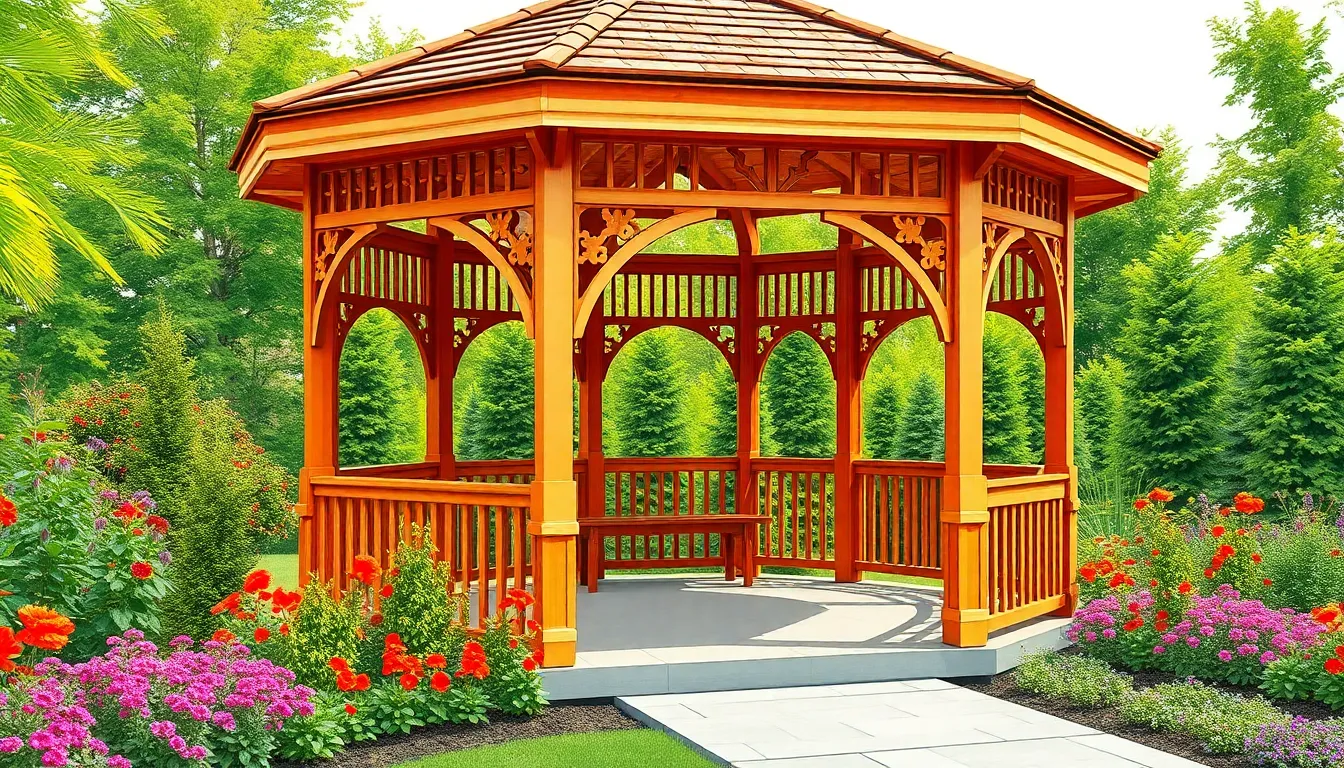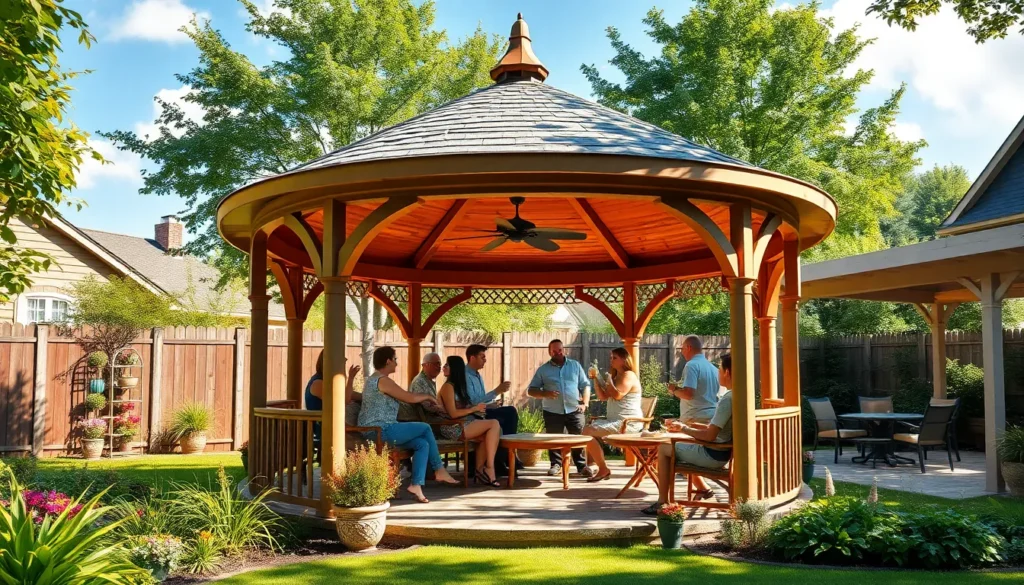Table of Contents
ToggleWhen it comes to outdoor spaces, choosing between a gazebo and a pavilion can feel like picking a favorite child—both have their charm, but one might just steal the show. Picture this: a sunny afternoon, friends gathered around, and the perfect structure to provide shade while elevating your backyard game. But which one reigns supreme?
Overview of Gazebos and Pavilions
Gazebos and pavilions serve as popular outdoor structures, each with its own unique characteristics. Gazebos typically feature a rounded or octagonal shape and come with a roof but remain open on the sides. These structures often enhance garden aesthetics and provide a cozy spot for relaxation or socialization.
Pavilions, on the other hand, usually boast a rectangular design with solid walls or partial walls. Designed for larger gatherings, pavilions offer more enclosed spaces while still promoting airflow.
The materials used vary significantly between the two. Gazebos often utilize wood, vinyl, or metal, allowing for different finishes and styles. Pavilions tend to use heavier materials such as wood and stone for sturdiness and permanence, often integrating with existing architecture.
Functionality distinguishes these structures as well. Gazebos are ideal for intimate settings or quiet afternoons, while pavilions cater to larger events like family reunions, parties, or outdoor dining. Comfort is enhanced in both options, but the pavilion’s larger area allows for various furniture arrangements.
Consider the location and purpose when choosing between a gazebo or pavilion. For instance, a small backyard might benefit more from a gazebo, while spacious gardens could easily accommodate a larger pavilion. Either choice significantly elevates outdoor living experiences, providing shelter from sun and rain.
Design and Aesthetics

Selecting a gazebo or pavilion impacts outdoor aesthetics greatly. Each structure offers unique stylistic elements that enhance the overall landscape.
Styles of Gazebos
Various styles of gazebos exist to complement outdoor settings. Many feature classic octagonal shapes that draw attention in gardens. Some designs emphasize intricate woodwork, creating a focal point for relaxation. More modern gazebos incorporate curved lines and open layouts, blending seamlessly into nature. Popular finishes include stained wood, painted metal, and vinyl, each contributing to charm. Customization options allow homeowners to match gazebos with personal tastes and existing architecture confidently.
Styles of Pavilions
Pavilions exhibit diverse styles that serve practical and aesthetic purposes. Often rectangular, many designs feature gabled roofs, which enhance architectural interest. Open-sided styles encourage airflow while maintaining a connection to the outdoors. Solid walls can provide additional shelter from wind or rain during gatherings. Some pavilions utilize stone elements, adding rustic sophistication to backyards. Communities increasingly adopt modern designs, reflecting minimalist tastes and merging functionality with elegance.
Functionality and Use Cases
Both gazebos and pavilions serve distinct roles in outdoor spaces, enhancing their functionality and appeal.
Outdoor Gatherings
Outdoor gatherings thrive under the shelter of pavilions, which accommodate larger groups with ample space. Individuals often utilize pavilions for events such as family reunions and community barbecues, thanks to their spacious designs. Gazebos, on the other hand, create inviting settings for small gatherings, including intimate dinners or quiet afternoon teas. Comfortable seating arrangements within gazebos promote relaxation, making them perfect for casual get-togethers. These structures can also serve as focal points in gardens, drawing attention and creating a welcoming atmosphere.
Gardening and Landscaping
Gardening and landscaping projects benefit significantly from the presence of gazebos. These structures offer a charming aesthetic, serving as a backdrop for floral displays and plant arrangements. Pavilions support gardening by providing shaded areas for resting amid landscaping efforts. Their solid construction allows for integration with hardscaping elements like stone pathways. Gazebos enhance garden designs while providing quiet spots to appreciate nature. Pavilions contribute functionality, facilitating outdoor workshops or gardening classes, making both structures valuable for enhancing outdoor experiences.
Materials and Durability
Choosing the right materials enhances a gazebo’s durability and longevity. Various materials serve different purposes, affecting both aesthetics and function.
Common Materials for Gazebos
Wood serves as a popular choice for building gazebos, providing a classic look and natural appeal. Cedar and redwood offer resistance to decay and insects. Vinyl stands out for its low maintenance and weather resistance, allowing for easy cleaning and durability. Metal options, like aluminum, provide strength and modern appeal while resisting rust. Each material brings unique benefits and visual styles to meet diverse preferences.
Common Materials for Pavilions
Pavilions often use stronger materials due to their larger structures and intended uses. Pressure-treated wood provides excellent durability and support for heavy roofs. Stone elements add a rustic charm while enhancing structural integrity. When considering modern designs, steel supports ensure stability and longevity. Composite materials combine aesthetics with durability, minimizing upkeep. The selection of materials directly influences the overall durability and function of pavilions.
Cost Considerations
Cost factors significantly influence the decision between a gazebo and a pavilion. Gazebo pricing typically ranges from $1,500 to $6,500, depending on size, materials, and design complexities. Pavilions generally come at a higher price point, starting around $3,000 and reaching up to $10,000 or more for larger or custom-built options.
Material choice impacts overall expenses. Wood structures often require higher upfront costs but provide longevity. Vinyl options may lower initial expenses while offering minimal maintenance needs. For pavilions, using stone or steel also affects the budget, as these materials increase durability and price.
Installation costs need consideration as well. Professional installation services could add $500 to $2,000 to the total, depending on structure type and site conditions. DIY enthusiasts can save on labor costs, but this option requires significant time and effort.
Maintenance expenses also differ. Gazebos often require periodic staining or sealing, while pavilions typically need less frequent upkeep, especially those made from durable materials. Annual maintenance budgets should factor in materials and time.
Local building codes can affect costs too. Some regions may require permits for construction, increasing project expenses. Understanding local regulations ensures compliance and helps avoid fines.
Ultimately, evaluating the long-term value of each structure plays a crucial role in the decision. Gazebos add aesthetic charm and intimacy, while pavilions provide functional outdoor spaces for gatherings. Considering individual budget, location, and intended usage ensures a well-informed choice.
Choosing between a gazebo and a pavilion ultimately depends on individual needs and preferences. Both structures offer unique benefits that can enhance outdoor living spaces. Gazebos provide a charming retreat for smaller gatherings while adding aesthetic appeal to gardens. Pavilions excel in accommodating larger groups and providing functional spaces for various events.
When deciding, it’s essential to consider factors like location, intended use, and budget. Each option has its own set of materials and design styles that can complement any backyard. By carefully evaluating these aspects, homeowners can select the perfect structure to elevate their outdoor experience and create lasting memories with family and friends.




